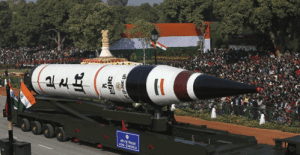THE CONTEXT: On March 11, 2024, India successfully conducted its first test of a new Agni-V missile with Multiple Independently targetable Re-entry Vehicle (MIRV) technology, together termed the “Divyastra (celestial weapon) Mission.” It was conducted by the Defence Research and Development Organisation (DRDO) from Dr APJ Abdul Kalam Island off the Odisha coast.
AGNI V
- The MIRV Agni-V is a three-stage missile with a modified system to accommodate multiple warheads.
- The missile also carries indigenously developed advanced sensors and guidance systems for greater accuracy of warhead delivery.
- One key aspect in extending the range of the 50-tonne Agni-V missile is the reduction of its weight.
- This involves replacing older, heavier sub-systems with lighter, more reliable ones, including components made with lightweight composite materials.
- A notable development in this regard is the replacement of hydraulic actuators in the Agni-V’s giant first stage with the state-of-the-art, electro-mechanical actuators that already equip Stage-2 and Stage-3.
MULTIPLE INDEPENDENTLY TARGETABLE RE-ENTRY VEHICLE (MIRV) TECHNOLOGY
- This technology allows a single missile to carry multiple warheads including nuclear warheads, each capable of being aimed at a different target.
- Functionality:In a MIRV- equipped missile, the warheads are housed in the missile’s bus (post-boost vehicle). Once outside the Earth’s atmosphere, the bus maneuvers and releases the warheads to descend towards their independent targets.
- Strategic advantage:MIRV technology enables a single missile to destroy several targets simultaneously complicating the enemy’s missile defense strategy. It significantly increases the firepower and deterrent value of a missile system.

How MIRV works?
- Launch:A MIRV-equipped missile is launched and follows a ballistic trajectory into space, similar to any other ballistic missile.
- Post-boost phase: After the boost phase, the missile’s upper stage, known as the “bus,” reaches a suborbital spaceflight. In this phase, the bus maneuvers and aligns itself based on the designated targets.
- Deployment: The bus sequentially deploys multiple warheads along with decoys and countermeasures. Each warhead can be assigned a different trajectory and
- Re-entry and Impact: The warheads re-enter the Earth’s atmosphere independently and proceed to their respective targets.
SIGNIFICANCE:
- Strategic Deterrence against China:The successful test of Agni-5 MIRV missile signals India’s readiness to counter China’s advancements in missile and missile defense capabilities. China has invested in ballistic missile defense systems, but India’s MIRV-equipped Agni-5 provides a counterbalance by enhancing India’s nuclear striking power and resilience against potential missile defense.
- Continued Advancements: India’s success opens avenues for further advancements in its nuclear arsenal, including the testing of long-range Submarine Launched Ballistic Missiles (SLBMs). With a range of over 5,000 kilometres, the Agni-5 is the longest-range missile India has tested so far.
- Regional Security Dynamics: The Agni-5 MIRV test underscores India’s commitment to maintaining regional stability and safeguarding its national security interests. MIRV-tipped missiles are a necessity simply because they strike multiple targets simultaneously and help evade ballistic missiles defences.
- Enhanced Nuclear Deterrent: The Agni-5 missile, with integrated MIRVs, represents a significant advancement in India’s nuclear deterrent. MIRVs allow for multiple warheads to be delivered simultaneously, increasing the potency and effectiveness of India’s nuclear arsenal. The potency of India’s nuclear deterrent is enhanced because this variant is integrated with Multiple Independently Targetable Re-entry Vehicles (MIRVs).
- Places India among advanced countries: The five designated nuclear weapons state the United States, Russia, the People’s Republic of China, France and the United Kingdom already possess MIRV capable projectiles which are integrated into their respective nuclear arsenals. India has joined a very select group of countries to develop an MIRV ballistic missile.
ISSUES:
- Technical Challenges: Developing MIRV-capable ballistic missiles requires meeting technical criteria, including warhead miniaturization, precise re-entry vehicle configuration, and guidance accuracy.
- India specific: India is, however, yet to produce and operationally induct MIRV missiles into its nuclear arsenal on different platforms. The other countries named have both land- and submarine-based MIRV missile systems. India faces major challenges in operationalising and deploying MIRV missiles.
- Drive ups risks of nuclear conflict: The possession of MIRV missiles is a double-edged sword as on the one hand, MIRVs seemingly bestow greater deterrence. On the other hand, they push rivals to adopt more aggressive nuclear postures to counter this advantage. MIRVs may, therefore, also drive up the risks of nuclear conflict and increase security threats.
- Opacity: The opacity surrounding this MIRV missile is about the number of warheads it can carry, which likely would remain classified. However, it is improbable that it can carry more than three warheads. Also, there is no information yet in the public domain as to whether it is planned to also equip India’s nuclear-capable submarines with MIRV missiles.
THE CONCLUSION:
The successful test of the Agni-5 MIRV missile enables India to reach a milestone as India has crossed a key benchmark to become a highly credible nuclear and missile power. However, as India progresses towards these advancements, it must navigate the complexities of regional geopolitics while upholding principles of strategic stability and nuclear restraint.
UPSC PREVIOUS YEAR QUESTIONS
Q.1 How is the S-400 air defence system technically superior to any other system presently available in the world? (2021)
Q.2 With growing energy needs should India keep on expanding its nuclear energy programme? Discuss the facts and fears associated with nuclear energy. (2018)
MAINS PRACTICE QUESTION
Q.1 Possession of MIRV missiles is a double-edged sword as it may provide greater deterrence but can also drive up the risks of nuclear conflict. Critically analyze the statement.
Spread the Word
